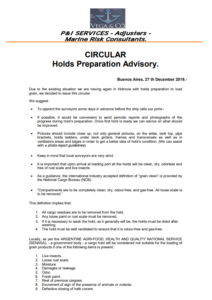Cargo hold cleaning is a major issue nowadays given that it is responsible for the quality of the product it will transmit; Therefore, the North Club issued information of cargo cleanliness requirements in Argentina for all interested parties.
Specifically, the Club informs that its correspondents in Argentina, Vega & Co., the Argentinian National Food Safety and Quality Service (SENASA), provided advises and information concerning hold cleanliness requirements when loading grain cargoes.
In addition, SENASA will not accept a “suitable” cargo for the loading of grain products if one of the items shown below is present:
- Live insects;
- Loose rust scale;
- Moisture;
- Damage or signs of leakage;
- Odour;
- Fresh paint;
- Residues of previous cargoes;
- Excrement or sign of presence of animals or rodents;
- Defective closing of hatch covers.
Vegas & Co. highlighted that
Keep in mind that local surveyors are very strict.
The P&I also expressed that the following are not acceptable and should be prevented:
- Lack of cleanliness behind frame;
- cargo residues wedged on holds ladders platform added to paint flakes and rust scales;
- cargo residues on pipe brackets;
- Cargo residues underneath hatch covers steelwork;
- Traces of previous cargo over tank top;
- Transferable stains at hatch covers;
- Presence of rust and debris on drain channel will eventually lead to the clogging of drain hole;
- Loose rust scales;
- Oxidation rust/ Rust dust on tank top;
- Unsanitary conditions;
- Wetness;
- Odours;
- Infestation.
To learn more on what Vegas & Co. advised, click herebelow
In light of cargo cleaning operations, in November 2019, a company launched an environmentally-friendly robot technology improving ship cargo hold cleaning. specifically assisting the dry bulk industry in hold cleaning operations, by reducing the risk of cargo contamination and decrease the cleaning costs.


































































